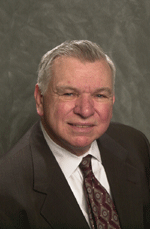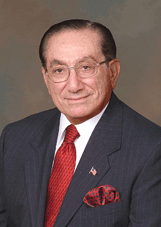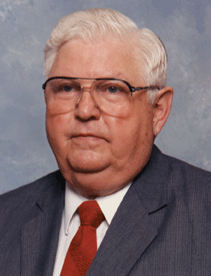2004 Honorary Members
Robert Mast

Robert F. Mast is Senior Principal and Director of Engineering Development at BERGER/ABAM Engineers Inc., Federal Way, WA. During his 44-year tenure with the firm and its predecessors, Mast has served in positions ranging from Junior Engineer to President and Chairman of the Board of Directors. He has dedicated his entire career to engineering excellence and the advancement of precast/prestressed concrete. Prior to joining BERGER/ABAM, Mast served in the U.S. Army.
An ACI member since 1959, Mast was ACI President from 1995 to 1996. He is a member of ACI Committee 318, Structural Concrete Building Code; the Concrete Research Council (CRC); the TAC Technology Transfer Committee (TTTC); and the Strategic Development Council (SDC). He is a former member of several ACI committees, including the Standards Board; the Technical Activities Committee (TAC); the Executive Committee; the ACI Young Member Award for Professional Achievement Committee; the Awards for Papers Committee; the Honors and Awards Committee; the Honorary Membership Committee; the Personal Awards Committee; the Reinforced Concrete Research Council (RCRC); the Responsibility in Concrete Construction (RCCC); and Joint ACI-ASCE Committees 352, Joints and Connections in Monolithic Concrete Structures, and 550, Precast Concrete Structures. Mast received the ACI Arthur J. Boase Award in 1997 and the ACI Arthur R. Anderson Award in 2003.
He was also recognized by the National Academy of Engineering, 1989, and received the American Society of Civil Engineers T.Y. Lin Award, 1969, 1973, and 2002, and the OPAL (Outstanding Projects and Leaders) Award for Design; the Engineer of the Year Award from the Consulting Engineers Council of Washington, 2000; and the Medal of Honor, 2001, the Martin P. Korn Award, 1992 and 2001, and the Charles C. Zollman Award, 2002, from the Precast/Prestressed Concrete Institute.
Mast received a bachelor's degree in architectural engineering from the University of Illinois at Urbana-Champaign in 1957.
Roberto Meli

Roberto Meli has been a Professor at the National University of Mexico since 1967, where he was recently named Professor Emeritus. In addition, he has been a visiting professor at the University of Texas at Austin and at the Technical University of Milan. He has also lectured extensively, especially in Mexico and other Latin American countries.
His research interests include the structural behavior of buildings, specifically the effects of earthquakes on concrete and masonry structures. He has acted as a consultant for the structural design of many urban buildings, industrial facilities, and underground and bridge structures. He has published more than 140 technical papers and four books.
After the 1985 Mexico earthquake, Meli headed the group in charge of the evaluation of its effects on buildings and of extracting the lessons for updating the practice of earthquake-resistant design. He coordinated the US-Mexico research program on learning from the Mexico earthquake and served as a Vice-President of the International Association of Earthquake Engineering (IAEE). From 1995 to 2000, he was General Director of the National Centre for Disaster Prevention (CENAPRED), where he was in charge of advising the National Civil Protection System on hazard evaluation and mitigation measures regarding the large variety of natural risks faced by the country. He has also been responsible for the drafting of several building codes and design norms in Mexico and abroad.
In addition, he has written papers for several ACI journals, conferences and symposia, as well as seminars and short courses. In Mexico, he received several awards including the National Prize for Science and Arts and the National University Prize, which was awarded for his contributions to technological development.
Meli received a degree in civil engineering and his Doctor of Engineering, in structures, from the National University of Mexico.
Edward G. Nawy

Edward G. Nawy is Distinguished Professor in the Department of Civil and Environmental Engineering at Rutgers University-The State University of New Jersey, having been a member of its faculty since 1959, including service as department chairman and graduate director.
A charter Fellow of ACI, Nawy has been active in the Institute since 1959. He is the founding chairman and current member of ACI Committee 224, Cracking, past chairman and current member of ACI Committee 435, Deflection of Concrete Building Structures; member of ACI Committee 340, Design Aids for ACI Building Codes, Joint ACI-ASCE Committee 421, Design of Reinforced Concrete Slabs, and previously member of ACI Committee 371, Concrete Pedestal Water Towers. He was the first chairman of the ACI Chapter Activities Committee, where he helped formulate several major policies, including establishment of roundtable conferences, codification of chapter charters, inspector certification procedures, and committee awards. He was twice president of the ACI New Jersey chapter.
Nawy is the recipient of the ACI Chapter Activities Committee Award, the Henry L. Kennedy Award, the Robert E. Philleo Concrete Research Council Award, and the ACI Design Practice Award. He is also the recipient of the National Research Council's Transportation Research Board Emeritus Honorary Membership in the TRB Committee on Properties of Concrete. He served two terms on the Rutgers University Board of Governors, one term on its Board of Trustees, and also served as evaluator for the Accreditation Board for Engineering and Technology (ABET) of the national Engineering Joint Council.
As a recognized expert on the serviceability of concrete structures and structural design and performance, Nawy has published in excess of 175 research papers, and is the author of three major textbooks used worldwide: Reinforced Concrete - A Fundamental Approach (presently in its 5th edition), Prestressed Concrete - A Fundamental Approach (presently in its 4th edition), Fundamentals of High Performance Concrete (presently in its 2nd edition), and a major volume: Concrete Construction Engineering Handbook. He is a licensed professional engineer in the States of New York, New Jersey, Pennsylvania, California and Florida, and a Chartered Engineer in the United Kingdom and the Commonwealth.
Ramesh N. Raikar

Ramesh N. Raikar is Chairman and Managing Director of Structwel Designers and Consultants Pvt. Ltd., a consulting firm he established in 1966 that specializes in structural engineering projects; repair; rehabilitation, and restoration; architectural planning; and the development of large industrial projects, housing complexes, public utility structures, and transportation facilities. In addition, the firm is involved in damage and failure investigations and peer review. Prior to this, Raikar worked for various government, semi-government, and defense organizations.
An ACI Fellow since 1989, Raikar is a member of the ACI International Conferences/Conventions Committee. He was instrumental in founding the ACI India Chapter, and currently serves as President. In 1983, he received the ACI International Chapter Activity Award. In 1994, he received a Special Recognition Award in Singapore for his "leadership role in the concrete industry in India" from CANMET/ACI. He is a member of various other national committees, codemaking bodies, and professional organizations, such as the Institution of Engineers; Institution of Valuers; Indian Concrete Institute; the Institute of Structural Engineers, UK; and the Canadian Society of Civil Engineers.
His interests include repair and rehabilitation, and he is credited with pioneering contributions in this field. Almost 25 years ago, he introduced the term "forensic engineering" to Indian engineers, and he has lectured widely on the subject throughout India and other countries and has participated as an expert committee member on several exclusive investigations of damaged and collapsed structures.
Throughout his professional career, he has studied the response and behavior of structures to various stimulants, serviceability aspects, and the equilibrium of structures with design inputs. He initiated nondestructive testing and material testing as essential parts of analytical studies of distressed structures. More than two decades ago, he started the first private sector material testing laboratory in India. Today, it is a full-fledged, accredited testing laboratory that is recognized as an "in-house R&D unit" by the government of India's Department of Science and Technology. He has also written more than 200 technical papers and four books, which are used in many colleges and universities.
Raikar received a degree in civil engineering from the College of Engineering, Pune, India, in 1962.
James M. Shilstone, Sr.

James M. Shilstone, Sr., is Chairman of The Shilstone Companies, Inc., Dallas, TX. He has more than 50 years of experience in the concrete industry.
He was born in New Orleans, and into the concrete industry, in 1923. His father owned a chemical laboratory, had heard of Duff Abram's theories, traveled with him, and expanded his laboratory to include concrete and other materials. As a young boy, Shilstone swept the laboratory floors, capped cylinders in plaster-of-paris on oiled sheets of marble and broke them in a hand-cranked testing machine. In 1938, he completed his first concrete mixture research.
In 1942, he entered West Point as a cadet and learned to live by the academy motto, "Duty, Honor, Country." He graduated in 1945 and served in the army 7 years, which included a tour in the Korean War. He returned to the Shilstone Testing Laboratory and expanded his knowledge and understanding of concrete.
Serving as a concrete consultant for a $600 million project in Saudi Arabia in the mid-1970's, it was Shilstone's job to prepare the specifications for cast-in-place, sandblasted architectural concrete. There was a problem-there were no standard materials and traditional mixture proportioning methods were not applicable. Working at a laboratory in Athens, Greece, he guided the research based on his knowledge of concrete basics. His findings are now widely accepted concrete mixture technology and have led to changes in ASTM, ACI, the U.S. Air Force, and an increasing number of state departments of transportation.
Shilstone was asked to speak during two recent workshops on infrastructure. The assigned subject was "Concrete-Why Can't We Build Them Like We Used To?" He knew the answers. He had been a participant and observer the many changes and an ardent researcher of the technology that produces the old concrete that is now out-performing the new infrastructure concrete. The problems can be reversed.
An ACI Fellow, Shilstone is a member of ACI Committees 211, Proportioning Concrete Mixtures; 301, Specifications for Concrete; 309, Consolidation of Concrete; and 325, Concrete Pavements. He is a former member of ACI Committee 121, Quality Assurance Systems for Concrete and TAC HPC. He received ACI's Wason Medal for Most Meritorius Paper in 1979 and the ACI Construction Practice Award in 1985.
Shilstone received his BS from the United States Military Academy at West Point in 1945.